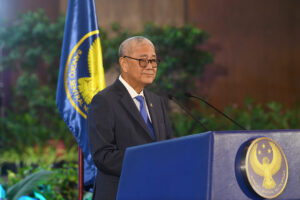DIGITAL BANKS find it difficult to disburse loans and collect payments from borrowers, the Bangko Sentral ng Pilipinas (BSP) chief said, with the regulator continuing its close monitoring of the sector.
BSP Governor Eli M. Remolona, Jr. said they have placed digital banks in a regulatory sandbox to test innovations and minimize risks in the sector.
“Digital banking is one of those in the sandbox. We’ve issued six licenses. These guys are actually very successful in collecting deposits just online. (But) they’re still struggling with figuring out how to make loans. That’s the hard part. That’s why they’re still in a sandbox,” he said during the Philippine economic briefing in Iloilo City on Monday.
In 2021, the BSP imposed a moratorium on the grant of digital banking licenses as it seeks to monitor the development of the sector, ensure competition among the new players, and boost its own capacity to regulate these new types of lenders.
The six online banks that secured licenses to operate in the country were Tonik Digital Bank, Inc.; GoTyme Bank of the Gokongwei group and Singapore-based Tyme; Maya Bank of Voyager Innovations, Inc.; Overseas Filipino Bank, a subsidiary of Land Bank of the Philippines; UNObank of DigibankASIA Pte. Ltd.; and UnionDigital Bank of Union Bank of the Philippines, Inc.
Mr. Remolona said during an event last week that digital banks are an “experiment.”
“A digital bank has to do everything digitally… Digital banks manage deposits easier than granting loans. The assets side is harder for digital banks,” he said in mixed English and Filipino.
“Lending through digital means is hard. According to some of these banks, collecting or asking borrowers to repay their loans still needs to be done through a person or a firm. It can’t be done purely through online platforms,” Mr. Remolona added.
He said digital banks having a high nonperforming loan (NPL) ratio is okay for now as it means they are becoming increasingly capable of lending to their clients.
Based on latest BSP data, the over NPL ratio of digital banks stood at 8.46% as of September, significantly higher than the 3.4% NPL ratio of the whole Philippine banking system.
The amount of NPLs recorded by the sector increased by 3.75% to P2.49 billion at end-September from P2.4 billion as of August.
Meanwhile, the total assets of the digital banking group stood at P82.29 billion in the first nine months of the year.
Last week, debt watcher Fitch Ratings said digital banks in the Philippines might be unable to compete against lenders with brick-and-mortar presence in the medium term, and their impact on the banking sector may be limited as the segment is still growing.
Fitch said the market share of system deposits of all digital banks was still less than 0.4% as of end-June despite their rapid growth in the past two years.
Low average deposits per customer also suggest that digital lenders have yet to capture most of their depositors’ operating accounts, Fitch said.
However, robust economic growth for the Philippines should provide some support to borrowers’ repayment capacity and asset quality in 2024-2025 for both digital and incumbent banks, it said. — Keisha B. Ta-asan
